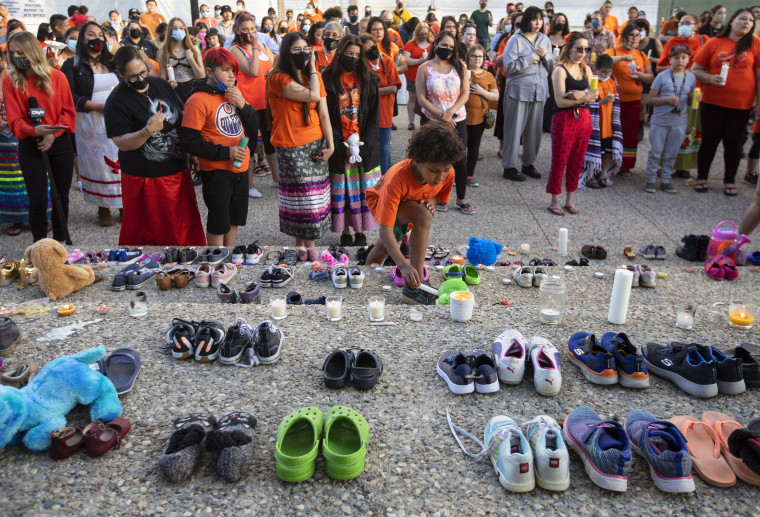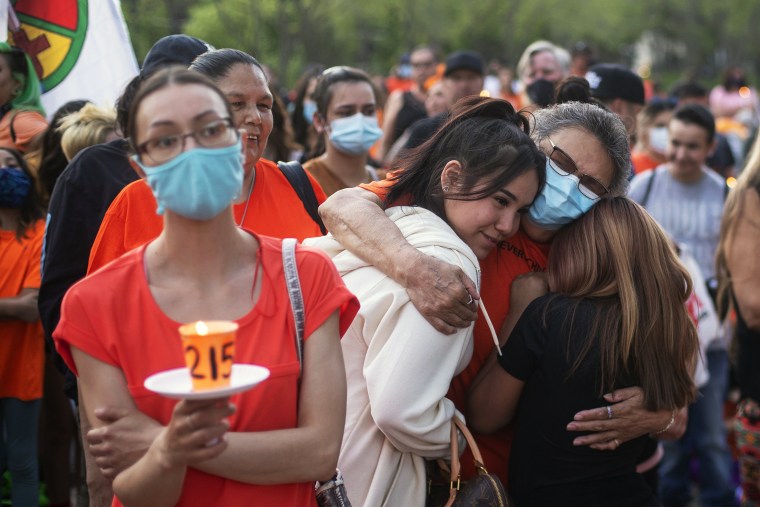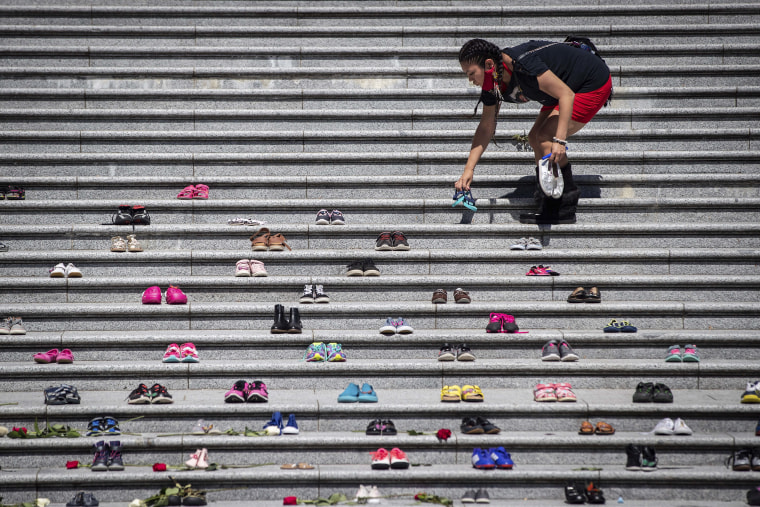Canada has been dealt a somber reminder of one of the darkest chapters of its history over the past week.
The remains of 215 children were found last month buried in unmarked graves at a former residential school, one of more than 150 institutions in a defunct system that for well over a century forcibly separated Indigenous children from their families to assimilate them into Canadian society.
The discovery sent shock waves through the nation, prompting communities from coast to coast to lower their flags to half-staff and hold moments of silence in honor of the children. From Vancouver to Ottawa, children's shoes, toys and candles have been left at makeshift memorials.
Now, lawmakers and First Nations groups are calling for all former residential schools across Canada to be examined for signs of unmarked graves.
For decades, residential school survivors have been telling "horror" stories about children who disappeared without a trace, Terry Teegee, regional chief of the British Columbia Assembly of First Nations, said by phone from Prince George, British Columbia.
"Finding these 215 children just confirms those stories," Teegee said. "It's really important, as part of a healing journey, to acknowledge and understand how many of our children perished in the schools."
Download the NBC News app for breaking news and politics
The school where the remains were found is in Kamloops, about 160 miles northeast of Vancouver. The institution, the biggest residential school in Canada, operated under the auspices of the Catholic Church from 1890 to 1969. The Canadian government then took over and oversaw the school until it closed in 1978. Enrollment peaked in the early 1950s at 500. There are official records of at least 51 children who died at the school from 1900 to 1971.
The graves, which were discovered with ground-penetrating radar last month, are believed to be undocumented, said Chief Rosanne Casimir of the Tk'emlúps te Secwépemc First Nation, who announced the discovery May 27. Searchers acted on a "knowing in our community" to look for the unmarked graves, she said.
Some of the children are believed to have been as young as 3, Casimir said.
In the wake of the discovery, Teegee is among a growing number of First Nations leaders calling for more former residential schools to be searched.
"It's part of the truth-telling in terms of true reconciliation," he said. "We need to know and understand where these children are."

While the sheer number of children's remains found in Kamloops is shocking, it is just the tip of the iceberg, and the discovery is by no means an isolated incident, said Linc Kesler, former director of the University of British Columbia's First Nations House of Learning. He supported the calls to examine other former residential school grounds, saying full acknowledgment of this part of Canada's history is "absolutely requisite."
Grand Chief Stewart Phillip, president of the Union of British Columbia Indian Chiefs, told the TV station Global BC: "If this has taken place at the Kamloops Indian residential school, there is no reason not to believe that it happened right across the country. I think we have not heard the worst of this."
An estimated 150,000 First Nations, Métis and Inuit children were required to attend the state-funded residential schools from 1831 to 1996. Many never went home.
In 2015, a Truth and Reconciliation Commission declared that the residential schools played a central role in Canada's "cultural genocide" of Indigenous people.
The schools were designed to force First Nations children to assimilate into Canadian society. Children were taken from their homes and communities, and students were harshly punished for speaking their own languages, according to the National Center for Truth and Reconciliation. The schools were often crowded and underfunded, and staff members were not held accountable for how they treated the children. Thousands of students suffered physical and sexual abuse, the center said.
The commission identified more than 4,100 children who died while in residential schools. The true number of victims may never be known because of incomplete or missing records.
A week after the announcement of the discovery in Kamloops, the story continues to dominate Canadian headlines.
Prime Minister Justin Trudeau said the news broke his heart; Carolyn Bennett, the minister of crown-Indigenous relations, said Canadians are now "confronted with the truth."
"Sadly, this is not an exception or an isolated incident," Trudeau said Monday.

Asked whether he would commit federal funding to future research and excavations at residential schools across Canada, Trudeau said that some money has already been allocated for initiatives around residential school cemeteries in previous budgets and that "there will be more that we will do." He did not elaborate.
Crown-Indigenous Relations and Northern Affairs Canada said in an email Tuesday that nearly $34 million was earmarked in 2019 over three years to support efforts to continue building a register of residential school student deaths and support the work of communities in finding, memorializing and commemorating the children who died at the schools.
Bennett and Indigenous Services Minister Marc Miller said Wednesday that the Catholic Church and the pope should apologize to the victims. Miller said it is "shameful" that an apology has not been offered before.
Examining more former residential schools could come with a string of challenges. Access could be difficult, as many have been sold off, repurposed or redeveloped.
Of the over 150 schools that were open in Canada, fewer than 20 have buildings that are still standing or partly standing, said Mary Ellen Turpel-Lafond, director of the Indian Residential School History and Dialogue Centre at the University of British Columbia in Vancouver. Access to the sites varies greatly, which can create barriers to research, Turpel-Lafond said in an email.
Then there is the issue of missing or incomplete records, which would be essential to identify the remains and understand how the children died.
Turpel-Lafond said some names were recorded with no first or last names, such as simply "Indian Girl No. 237" — evidence of the inadequacy of the records. Misspelling of cultural names, new names that were assigned in English and French or anglicized versions of names mean records are difficult to navigate, she said.

Finally, there is an issue of how to deal with the unmarked graves.
Turpel-Lafond called on the government to appoint a special rapporteur to bring international standards to Canada when it comes to mass burial sites.
"Mass graves are a legacy of conflict and human rights violations in other parts of the world — such as Srebrenica, Bosnia and Iraq," she said. "We need to show survivors that we take this discovery seriously, and treat it with respect."
Kesler said the United Nations could play a significant role through its Declaration on the Rights of Indigenous Peoples to bring attention to the deaths and "really add to the demand for accountability."
The U.N. Human Rights Office said in an email Thursday that Canadian authorities should ensure "prompt and exhaustive investigations" into the deaths of Indigenous children and "redouble efforts" to find their bodies, including by searching unmarked graves.
The Tk'emlúps te Secwépemc First Nation in Kamloops is working with a radar specialist to complete the survey of the school grounds. It expects a full report by mid-June.
Casimir of the Tk'emlúps te Secwépemc First Nation told the Canadian public broadcaster CBC on Sunday that there will be a debriefing with the nation's membership this week, adding that other chiefs across Canada are having similar conversations with their communities.
"We're all grieving," Casimir said. "There's so many unanswered questions that our membership wants. The world wants to know."
CORRECTION (June 3, 2021, 7:55 p.m. ET): A previous version of this article misstated when the graves were discovered. They were discovered the weekend of May 22-23, not earlier this month.
